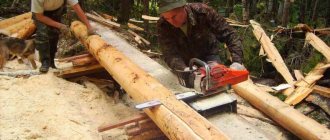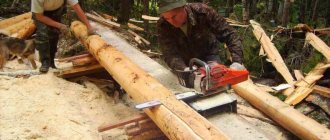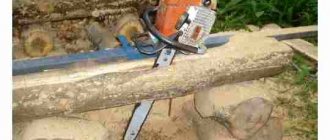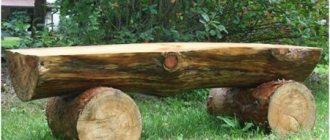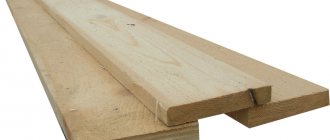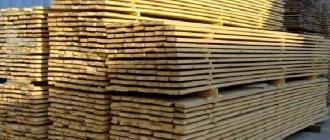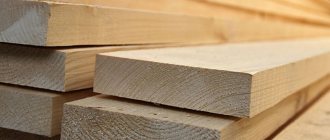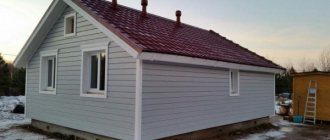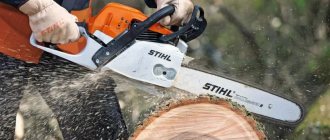Firstly.
We pay attention to all the bends and bulges of the log - a perfectly straight trunk is rare. Therefore, we try to turn it so as to get as little waste as possible from it, such as croaker. When the log is laid and fixed, you should make sure that it passes freely between the guide rollers.
Set the diameter size on the ruler of the sawmill, and to this size add the greatest height of the convexity of the log. This is the bulge that is higher than the diameter of the top or narrowest part of the log.
Using a regular tape measure, measure the height of the highest part, and from this size you begin counting the dimensions of the required material, taking into account the size of the cut, which ranges from 2 to 5 mm.
Preparing for work
Before starting work, it is recommended to sort the trees depending on their purpose. It is necessary to clean them from dirt, remove knots and nails. Sorting is done according to the following criteria:
- trunk diameter;
- curvature;
- number of knots, various defects;
- core diameter.
Immediately before cutting you need to:
- Check the quality of fastenings and connections of parts.
- Check for grounding.
- Lubricate surfaces subject to friction.
- Check that the band saw is installed correctly.
- Check the belt movement at idle and reverse.
- If necessary, change the saw boom by moving the roller on the left side by 5-10 cm.
The log, prepared in this way for sawing, is placed on the frame and securely secured with clamps. You need to make sure that it moves freely between the guides.
Equipment for cutting logs
The most famous type of equipment for dissolving logs into lumber is a sawmill. As the name implies, a sawing machine of this type has frames on which the cutting parts are fixed. By moving the frames along the log, it is cut.
The operation of a band sawmill, a video of which can be found on the Internet, will give an idea of the operation of this equipment. This machine allows you to process logs with a diameter of up to 80 cm and a length of up to 7 meters. The design of band sawmills comes in two types: vertical and horizontal. In both types of such equipment, the blade is responsible for cutting the wood.
How to cut a log into smooth boards and beams
It is quite difficult to cut wood straight along a log. After all, the same thickness must be maintained along the entire length. For this, there is special equipment that is attached to the log.
Many people make their own sawmill to cut logs at home.
How to make a home sawmill with your own hands
Let's look at the two most commonly used options for making a sawmill.
Option one
- We weld the frame from channels and profile pipes
- We attach a saw with an electric or gasoline drive to a carriage with vertical feed
- Attach a ruler to a vertical stand to make cutting onto boards as accurate as possible
- Use a polished pipe or rod as a guide for the carriage; they are needed for the carriage to move vertically.
- We install a screw in the bearing so that it moves the carriage when moving
With this option, it is the saw that is set in motion, on a specially attached frame, and the log remains in place. In this case, a chain saw will cope with the task faster. If you plan to use a reciprocating saw, the process will take longer because it works in one direction.
Secondly.
As soon as the width of the cut reaches the required size, and the remaining height of the log has reached the desired size, it is turned over. That is, if you cut a beam, for example, at 150, then both the width of the cut and the height of the remaining log should correspond to this value, even be greater, taking into account the removal of the slab.
Next, we know the final size of the material that needs to be obtained, and we will obtain it.
To do this, after turning the log over, start calculating from the final size until the full height of the log is used, but do not forget to take into account the size of the cut, which, as we already know, ranges from 2 to 5 mm.
For example, you have a log on your overpass that you have cut to a size of 260 mm. Let's turn the log over and continue.
The final result we want to achieve is a carriage with a thickness of 150 mm. Next, in a simple way, calculate that 260 mm-150 mm = 110 mm. We get as much as 110mm of extra material thickness. And it is precisely this that needs to be calculated correctly.
We take this additional size and calculate it to get the block, which has a size of 50 mm, 110-50 = 60, don’t forget the cut, and for us it is 2 mm, 60-2 = 58 mm, then the plank, equal to 25 mm, 58 -25-2=31 mm, hump 20 mm, 31-20-2=9 mm.
As you can see, from our calculations, we get 9 mm slab, 20 mm slab, 25 mm gorge and 50 mm block. And the final size will be 150 mm.
Quantity of finished material, cutting price
The yield of useful material from coniferous and deciduous trees differs in percentage. The following indicators are typical for lumber obtained from coniferous trees:
- provided that the operation is carried out by a professional and a circular sawmill is used, the percentage of finished wood will be the highest (80-85%);
- the edged material produced by the machines averages 55-70%;
- When used with a chainsaw, an unedged board leaves up to 30% waste.
The figures are given without taking into account the finished culled timber, the amount of which can reach 30%. However, such material is used for products that allow certain defects.
Deciduous round timber produces 60% of the finished unedged timber and about 40% of the edged timber. This is explained by the initial curvature of the round timber. It is possible to increase the amount of products obtained: this will require forest processing machines of various types. A certain kind of device can increase the amount of lumber by 10-20%. For one cube of lumber you will need about 10 cubes of deciduous round timber. The cost of installing additional equipment will be recouped by the cost of the finished timber. Special lines provide greater volume, but their use is only advisable over a large area. The average price of sawing wood at a regular sawmill will be approximately 150-180 rubles per cubic meter of boards.
Cutting technology
When choosing a technology for sawing logs into boards, the characteristics and dimensions of the wood are taken into account. There are three ways to work on a band sawmill:
- Sawing into collapse. The tree is cut in a straight line to the end without turning over. The output is unedged boards. The downside is the low quality of the resulting material and a large amount of waste. The resulting boards must be further trimmed. During operation there is a high probability of cracking.
- Circular sawing. After the first cut, the log is turned over to the other side. Usually five revolutions are practiced. The method allows you to cut logs to size with a minimum amount of waste. The disadvantage of this method is the low production speed.
- Sawing timber. The main part of sawing logs is carried out in a circle. The central part is cut out in the shape of a beam. For these purposes, as a rule, the largest logs are used.
The technological process of sawing includes the size of the board and the rotation of the log.
Turning a log
After the sawmill blade has reached the desired height, the trunk is turned over. Unsawn material is measured and calculations are made for its use. Next, the log is turned 900 and the measurements are repeated. When making calculations, it is important not to forget to make allowances for cutting.
First cut
There are two options for starting to cut wood, depending on the selected edge:
- Start cutting from the worst part. In this case, there is no need to take into account the tilt of the barrel. When sawing this edge, boards of short length and a large amount of unedged material are obtained.
- Start cutting with the best part. In this case, the log must be installed so that the saw is parallel to the tree bark.
Since in the first option the best part of the trunk is hidden, errors are possible during further sawing. This method is more suitable when working with low quality wood.
Flipping the log
While working at the sawmill, the log is turned over according to the cutting diagram. The revolution is carried out in two ways:
- Turn 180°, in this case unedged boards are obtained.
- Turning 90° produces unedged and semi-edged boards.
Using the first method, you can get wider boards. The second method is more convenient, since it is easier to turn the log over at this angle.
Types of log cutting
How to properly cut a log to obtain an optimized yield of lumber? You need to choose a suitable cutting pattern. This action is determined by various factors: the type of wood, the volume of logs, the unit system and the grade of lumber that will need to be produced. In addition, you should take into account how the lumber will be trimmed in the future.
In practice, the following 3 schemes for classical cutting of logs on a sawmill are known:
- Sawing logs in a circle. This cutting configuration is beneficial for medium to high quality logs. First, a cut is made, then the log is turned over to a new edge, then sawed again, and turned over again, and so on until at best 5 turns occur.
- Elementary sawing of a log (or ordinary sawing through). It is rational to use a similar scheme for low-quality wood. The resulting lumber will be more susceptible to warping during drying, in contrast to the first scheme, and will also come out heavier and drier with a larger volume of residues, since each element will then need to be sawn on the sides. In this cutting model, the log is sawed until its central part is revealed. Then it turns 180º and is sawed to the end.
- Sawing timber. This cutting combination is typically used when working with medium to large wood. In this case, the log can be of medium and low quality and is sawed in the same way as in circle sawing. However, the core part of a log with dimensions of 18x23 cm or 25x25 cm is not sawn. Such timber is either sold as is or is processed on other units according to the technological direction.
When using one or another model for cutting logs, the productivity of the sawmill increases and time and effort are saved on the production of products of various quality. (Fig. 1 Sawing logs at a sawmill)
Sawing tool
Modern band sawmill.
Logging is carried out using a special tool. For normal work by today's standards, you need a special machine for cutting logs with your own hands, which is called a sawmill.
There are two types of sawmills: disk and belt. Circular saws use circular saws and are considered less efficient, as they have a larger cutting thickness (from 6 to 9 mm), less accuracy and depth.
The band sawmill is equipped with a different system: the saw is a band mounted on rotating rollers. The cutting thickness is approximately 1.5 – 3 mm, which is quite economical in terms of waste to chips.
Modern models are distinguished by high accuracy and productivity; they are automated and have a tilting mechanism for lifting and turning logs in the case of circular sawing or sawing timber.
Using a chainsaw, you can only cut a log in half, but if you use a special frame, you can cut the log into boards right in the forest.
Working with a frame and a chainsaw.
Important! The band sawmill is considered the most efficient and cost-effective.
Tools and equipment
Trunks and large branches are used for production. All material is divided into groups according to thickness and presence of bark. Often, timber processing enterprises have workshops near the harvesting site, in which machines for the initial processing of wood are installed.
Manual debarking of wood
Wood that has not passed the debarking stage can be used on floors or as ridge beams in the corresponding interior, or as a supporting device during construction.
Industrial debarking of forests
If another option for using the wood is planned, then sawing is carried out, resulting in the following segments:
- unedged and semi-edged (rough material from which the bases of the floor, walls or ceiling are mounted);
- edged (intended for finishing flooring).
The cutting can be carried out by a mobile organization that has all the necessary tools.
Wood cutting map
Rational use of the material is ensured by compliance with the cutting map. This allows you to reduce costs due to waste, the percentage of which the card can significantly reduce. The tools and types of forest processing equipment used depend on the volume, desired quality and size of the finished lumber.
Wood sawing machine
The most commonly used are a circular saw and various machines:
- The circular saw allows you to make precise cuts in various directions. Suitable for both professional and home use, it copes well with above-average round timber diameters;
- chainsaw;
- machines for clean bark removal;
- sawing on a band sawmill makes it possible to process dense logs; it is considered the most popular, since the output is high-quality material and a small amount of waste;
- disk machine: production of double-edged timber and unedged boards;
- a frame sawmill does not require a foundation, the technology using it allows you to install the equipment in close proximity to the felling site;
- the fine gauge is processed by universal machines, the output is high-quality building materials even from low-grade logs;
- sawing of round timber at a large woodworking enterprise should be carried out with the largest amount of lumber, differing from the rest in its special quality and precise dimensions. For this purpose, special lines are installed for sawing.
At the sawmill, timber and edged boards are obtained by cutting logs up to 7 m long and 15-80 cm in diameter along the longitudinal line. A circular saw has one or more disks and processes wood of different diameters according to their number.
If you need to process a small amount of wood at home, you can use a regular chainsaw.
Possible mistakes
As you can see, there is nothing complicated here. Often, inexperienced sawmills make mistakes in calculations when they start counting from zero. For example, if the final size of the material is 150 mm, then there is no need to add 2 mm to it for the cut, otherwise it will be 150 + 2 = 152. There should not be such an error, the cut is calculated only between the material, for example, 50 mm board and 150 mm carriage, we get it as described above, 150 + 50 + 2 = 202 mm.
If it is necessary to obtain edged material, we turn the log 90 degrees and perform the same manipulations as described above.
So you have cut your first log, look at the quality of the material and the accuracy of the dimensions. Make sure your calculations are correct. The main mistake when making calculations is that they forget to take into account the size of the cut. Try to take this fact into account. And don't make such mistakes.
In the future, when you gain experience, the calculation will happen automatically in your head; it will be enough to look at the log.
We are sure that everything will work out for you, we wish you success in your work.
Another variant
There are a large number of similar attachments on the market. All of them are suitable for sawing logs into boards, they all have a similar design. But there are also differences. The photo below shows accessories for a chainsaw, which does not require additional accessories or tools to operate. In essence, this is a miniature manual sawmill, which is based on a gasoline saw.
Manual sawmill
The design is complemented by guides and wheels that move along the surface of the log, reducing resistance. There are two pairs of wheels, they are located on opposite sides of the workpiece. It’s convenient, easy, and, on the plus side, the quality of the cut material increases.
The nozzle is attached to the chainsaw in exactly the same way as in the previous case. The main requirement for the work is to accurately install the saw so that it is in a horizontal position. And although the oblique cut turns out the same, it is more convenient and easier when the tool is positioned evenly.
Types of working attachments
When sawing logs with a chainsaw, various attachments are used.
- Attachment for longitudinal sawing. It is used for sawing logs lengthwise, the process takes place in a horizontal position. After work, the master receives the same thickness of the product. The finished materials undergo a drying process, after which the boards are used in construction. In appearance, the device is a small frame; it is attached to the tire on each side.
- Drum debarker (debarker). With the help of such an attachment it is easy to dissolve the log; it works due to a V-belt drive. Attached to belts on both sides, special pulleys are used for this. The speed of rotation of the shaft depends on the size of the pulleys, so the performance of the attachment is easy to change. This technology forces the master to carefully monitor each stage of the process; some specialists use an assistant during this cutting. But this option requires increased security measures.
- Sawing with a lightweight nozzle. The method is not very productive, but is used quite often. The element is fastened on one side, but the workpieces are slightly uneven. Such materials are necessary for the construction of sheds or fences.
Setting up a sawmill
Selection of Coolant Solution
It is incorrect to saw on a band saw using water as a lubricant. It is better not to use lubricant until sawdust has been “rolled” onto the saw. If this happens, the optimal treatment is: 1/2 lubricating oil for chainsaw tires, 1/2 diesel fuel. The mixture is applied on both sides of the saw blade, but the amount of cooling solution is small.
This lubricant will extend the service life of sawmill pulleys and reduce the number of boards with traces of blooming.
Strain relief
Saw tension on a band sawmill
The blade heats up during sawing, which causes it to stretch in length. After cooling, the tendency to contract begins. At this moment, overload occurs due to excess tension, and cracks may appear.
The blade remembers the shape of the pulleys; deformation of the pulley belts occurs, which can lead to vibration of the blade. The hump on the belts is jammed, ensuring self-centering of the saw. When stopping sawing, the tension on the saw must be removed.
Band saw routing
The optimal wiring is considered when there is a mixture of 2/3 sawdust and 1/3 air between the saw blade and the wood being cut. If 80% sawdust is ejected, the saw is set correctly.
If there is a lot of loose sawdust on the cut, and there are scratches on the surface of the board, the saw will move more than necessary. The saw functions jerkily. If the spread is insufficient, hot sawdust, tightly compressed, will remain on the surface of the boards during the sawing process; this situation has a detrimental effect on the saw. And after cutting the wood, waves will remain on the material.
Before cutting, the logs are sorted by diameter:
The best saw settings
- For a larger diameter, the spread increases, but it is performed only on 1/3 of the tooth from above.
- For soft wood, the spread should be increased; sharpening should be done after preparing the equipment, with obligatory observance of the tooth shape.
The indicator of the divorce device works in a stressful mode and often goes astray, so constant checking is necessary.
It is recommended to maintain a sharpening angle of 10–12 degrees, soft wood – up to 15 degrees, hard and frozen wood – 8–10 degrees.
Sawing speed
Increasing the sawing speed results in a cleaner cut, but the service life of the saw is reduced. If the quality of the cut decreases, it is necessary to reduce the feed speed. For the initial 5 minutes, the equipment operation indicator should not be more than 1/2 of the maximum value.
Advice on what to do if a “wave” occurs when sawing
Many sawers are familiar with this problem: when sawing, an uneven surface of the board is obtained, a “wave”.
The problem is really serious, but with the right approach it is completely solvable. Let's sequentially analyze all the factors influencing the sawing process. There are only four of them: operator , machine , saw , wood .
Operator
The first item on our list can sometimes be the last. After all, it is the operator who determines the correct settings of the machine, the choice of sawing speed and the selection of saws depending on the type of wood. The cutting speed should be as close as possible to the maximum speed for the type of wood. If the sawing speed is insufficient, the surface takes on the appearance of a washboard. If the speed, on the contrary, is too high, the saw no longer has time to make the cut and, as a result, a “wave” appears .
Particular attention to setting up the machine! Often, even experienced operators do not pay due attention to the condition of the machine, citing the fact that adjustments take a lot of time. And the machine is serviced once a week, or even less often. Indeed, adjusting and repairing the machine in this case is a rather lengthy process: after all, over the course of a week, many problems accumulate that were never thought of before. Our recommendation: check the machine settings every day, and always after possible contact of the saw support rollers with the log. Checking does not mean adjusting, and it takes little time. The operator is also responsible for control over the selection and condition of saws.
Machine
Let's consider which parts and components of the machine can provoke the appearance of a “wave” during sawing. Saw guide rollers. They determine the position of the saw relative to the bed (rail track) of the machine. So, first we inspect the rollers . They should not have wear marks on the working surface, leading to vibration of the saw blade. There should be no deep marks on the sides of the rollers that would form if the rollers did not rotate when the saw moved. In addition, the condition of the bearings is checked. Only a very small amount of play is acceptable. If the bearings are replaced, it is necessary to check how they are seated in the roller housing. If the mounting holes are broken, you will most likely not be able to eliminate the play by replacing the bearings, and the newly installed bearings will quickly fail. We recommend replacing the roller assembly. After replacing defective components and parts, the saw rollers are completely adjusted according to the factory instructions. To ensure uniform pressure of the rollers on the saw when moving the movable roller from one extreme position to another, the guide of the movable roller must move in a plane parallel to the plane of the bed. Also check that there is no play in the movable roller guide clamp assembly. Even a slight backlash is unacceptable here. Adjusting the position of the saw on the working pulleys. A large run-off of the saw from the pulleys leads to stretching of the trailing edge, and as a result, the saw becomes unstable in the cut. In this case, the defect does not appear immediately, sometimes after the second or third sharpening, and the operator naturally suspects that the blade is of poor quality. But the new saw, after several sharpenings, cuts just like its predecessors.
Saw
Having made sure that all machine settings comply with the recommendations, we move on to the main “culprit” for the occurrence of the “wave”. It was, of course, a saw. First of all, it is necessary to remember that the key to success in sawing is strict adherence to the instructions for sharpening band saws. Most often, a “wave” occurs when sawing with dull saws. If the setting is insufficient, the sawing speed sharply decreases. In addition, the saw, even if it is sharp enough, heats up during operation and its tension has to be constantly restored. The sharpening angle also affects it. If this angle is greater than optimal for a given type of wood, the saw is overloaded (stuck), and if it is insufficient, the sawing speed decreases. The unevenness of the wiring deserves special consideration. If the setting is different from tooth to tooth, the “wave” will be random in nature, and will depend mainly on the uneven density of the wood. If the routing differs for different sides of the saw blade, the “wave” will depend on the predominance of the routing value (in one direction or the other) and will appear when the sawing speed changes. The presence of such a defect is indirectly indicated by the fact that after entering the wood the saw dives down or rises up. A saw whose tooth pitch or tooth height changes from tooth to tooth will cut jerkily and with significant vibration. We must not forget about the harm that unremoved hangnails cause. In addition to increasing the risk of saw rupture, the presence of burrs leads to braking of the saw in cutting, its heating, and, consequently, to the appearance of a “wave”. Often the saw is damaged when it comes off the pulleys or when it is not properly released from a jam. They usually straighten such a saw and try to cut it further, but you can no longer achieve a high-quality cut from this saw.
Wood
Let's consider those characteristics of wood that affect the formation of a “wave”. First of all, this is the uneven density of the layers. In most cases, the density of the core of the log is significantly less than the density of the outer layers. Therefore, the amount of sawdust when sawing the core is greater. The saw, encountering such areas on its way, can no longer cope with the removal of sawdust. As a result, its back part heats up and increases in size. The saw bends in the cut, and we see the appearance of a “wave”. It is difficult to select the parameters of the saw in such a way that it cuts both hard outer and soft inner layers equally well at the same time. We recommend changing the cutting pattern or leveling the surface after receiving the timber. The appearance of a “wave” when sawing frozen wood is well known to most operators. And if sawing completely frozen wood does not cause any special problems, then sawing slightly frozen or partially frozen logs is a very, very difficult task. The sawing technique here is the same as when sawing wood with unequal density. When sawing wood with a large number of knots, the risk of a “wave” increases many times over. In this case, you need to cut very carefully and smoothly, and then just as smoothly increase the feed speed as you pass each knot. Sawing very resinous wood causes particular problems. The fact is that the adhesion of sawdust and resin to the saw blade is equivalent to an increase in its thickness. And since the thickness of the cut does not change, the saw begins to rub against the walls of the cut, heats up and, as a result, the tension drops. The "wave" will appear immediately. Use cleaning fluid.
Useful tips!
In order for sawing at the sawmill to proceed without any problems or complaints, you should pay attention to the following factors that may arise during the work process:
- Uniform feeding speed of material during operation;
- Correct blade shape;
- Carrying out the correct layout of the saw;
- Do not allow resinous substances to stick to the canvas;
- Watch the saw teeth.
Features and characteristics of band sawmills
Gasoline band sawmills, videos of which can be found on the Internet, have more bulky dimensions and the need to take into account the removal of exhaust gases. With electrically driven equipment such difficulties do not arise.
Types of band sawmills
Electric band sawmills are available in various modifications. A wide range of models allows you to choose the equipment that is suitable for solving each task. A special feature of working on band sawmills is the low consumption of raw materials. Unlike circular saws, the amount of waste from such equipment is much less. This will reduce production costs and increase income. Which is extremely important in a small business environment.
Sawing map
The sawing map is a calculation of the optimal amount of finished lumber from one log. You can calculate it yourself for each specific log diameter, or you can use a computer program that greatly facilitates the calculation, and the price of which is quite affordable.
Material yield after cutting wood
Or the source could be a regular sawmill reference book. The result is a table that is used as a basis. The sawmill attachment should always be oriented to its data in order to obtain more lumber of any type of wood.
First cut
Of all the problems facing the sawyer, deciding which side of the log to start cutting on (and therefore which cut surface to open first) is the most important. (As already mentioned, we divide the log into 4 sides, each of which extends along the entire length of the log and occupies 1/4 of its circumference). The choice of the first face is determined by the position of all the others. Before sawing begins, a log can be cut in millions of ways, but only a hundred of them will actually be profitable! Having decided on the first cut, the sawyer only has a few thousand other decisions left to make.
In the case of circle sawing and sawing timber, two basic rules apply.
Rule 1. The worst edge of the log is cut first, without any regard to the taper of the log. (Running a log means raising or tilting the log so that the saw runs parallel to the bark). Since this is the worst part of the log, it will make short boards and a lot of slabs. Since we do not take into account the taper of the log, this gives us the opportunity to cut parallel to the bark from the opposite, better side of the log, without lifting or tilting the log. This means that from this best part of the log more boards of high quality will come out, which also match the length of the log.
Rule 2. Cut the best edge of the tree first, taking into account the taper of the log. This means that the log needs to be raised or tilted so that the first cut is made parallel to the bark.
The end result of both methods will be approximately the same, but the second method has one advantage: in this case, it is easier for the sawyer to position the log (i.e., rotate it), because the open edge is the cleanest and has no defects. In the case of Rule 1, the best part of the tree is opposite the open face. It is not visible, and it is impossible to accurately position the log. Typically, if the wood is of good quality, rules 1 and 2 work pretty much the same. However, if you encounter a worse log, take rule 2 into account.
Log sawing
The main task
The photo shows a corner sawmill.
In the old days, entire tree trunks were used to build houses and other structures, from which so-called log houses were assembled. However, cylindrical cone-shaped parts are not best suited for construction, so they began to make boards and beams from logs.
The proportion of solid logs used in construction is vanishingly small, so the logger must master the art of sawing the forest into boards and timber, otherwise he will go broke. This skill will also be useful for those who decide to do the preparation themselves for the needs of private construction.
The wood is used primarily in the form of planks.
So, we are faced with the task of turning an ordinary log into the maximum amount of high-quality useful lumber with minimal expenditure of energy, time and raw materials. That is, we must find a way in which efficiency will be maximum and costs will be minimal.
Here it should be said right away that the solution does not come down to solving a geometric puzzle; in practice, everything is much more complicated. Wood is a heterogeneous material, so the result is influenced by a large number of nuances and subtleties, which we will discuss in more detail in the following chapters.
The heterogeneity of the wood structure complicates the task of sawing it.
Important! The task of sawing is to obtain the maximum amount of high-quality lumber at minimum costs per unit of time.
Cutting methods
Special equipment will help you understand how to cut a log lengthwise.
As already mentioned, the correct calculation of cutting a log should take into account not only geometric parameters and cutting, but also the heterogeneity of the structure of the material.
The fact is that wood exhibits its properties differently depending on the orientation of the annual rings (layers): the processes of warping and deformation during drying are most clearly manifested along the layer, when the plane of the board coincides with the plane of the annual ring.
Not only beauty, but also quality depends on the cutting method.
To understand how to cut a log correctly, you should know the basic cutting methods:
- The radial method is considered the highest quality and is distinguished by the fact that the annual lines at the end of the board form an angle of 76 - 90˚ relative to its plane, and the cut line passes through the core of the trunk like a radius. The result is a board that is fairly uniform in color and texture, which practically does not swell when moistened and does not deform when dried. Radial cut lumber is considered the highest quality, its price is the highest;
- The tangential method, on the contrary, is the least preferable and is distinguished by the fact that the lines of the annual rings run almost parallel to the plane of the board or tangentially. The coefficients of swelling from moisture and shrinkage in the case of tangentially sawn boards are approximately two times higher than with radial sawing. In general, such boards are less durable and of lower quality, but at the same time they can have a very beautiful fiber pattern;
- The rustic method is something in between - the angle of inclination of the annual lines in relation to the plane of the product is in the range of 45 - 76˚. This group also includes a mixed type of cutting, which may contain elements of arcs, both during tangential sawing, and inclined and even perpendicular lines. In properties, these groups are a cross between the radial and tangential groups;
- Central cut. It is made in the center of the trunk and includes its core. Such boards are considered the least durable and most heterogeneous of all of these.
Methods for sawing logs.
Important! Most construction lumber is produced by rustic sawing, and there is also quite a lot of tangential lumber. When purchasing, you can easily distinguish them by eye.
Sawing schemes
You should decide on a work plan in advance.
One of the most important tasks of the sawyer is to choose the most rational cutting scheme. The compliance of materials with the goals set, the amount of output per unit volume of forest and, as a result, the profit of the enterprise will depend on this.
The master must have impressive experience and a special flair for the material in order to determine in advance the order of work, where to start and how exactly to act in the process. Such a skill comes only with time as a result of long work at the sawmill.
There are three standard log cutting schemes:
| Sawing diagram | Peculiarities |
| Circular | After removing the first slab, the log is turned over 180˚ and placed on the resulting edge. Then during the process it is turned over 180˚ or 90˚ more times, usually at least five turns are practiced. |
This is the most rational and economically beneficial method, however, in the absence of mechanisms for turning over when manual labor is used, the resulting productivity may be reduced
Homemade attachments
Masters have long learned to do a lot of things with their own hands. There is a huge variety of frame designs on the Internet that allow a chainsaw to cut logs into boards. There are simple manual options, there are large complexes of a frame and guides, with the help of which the tool moves or the log rises/lowers. One of them is in the video below:
Please note that the structure is assembled from metal profiles, which makes it reliable and stable. At the same time, the machine (it simply cannot be called otherwise) is equipped with mechanical gearboxes that simplify the process of moving the workpiece barrel and the chainsaw. No manual effort, just turn the handle from the gearbox. In this case, the thickness of the boards is adjusted by lifting the log, and not with a gasoline tool.
Another option is an attachment that helps make cuts not in a horizontal plane, but in a vertical one. The design is simple, but it is more difficult to work with because you have to make an effort to hold the chainsaw. In addition to the device, you have to prepare a metal strip or board, which is attached to the log in the longitudinal direction. It is on this that the frame-nozzle rests when cutting is carried out.
In addition, this option is more dangerous, because nothing holds the board being cut. She may hit her leg if she falls. So the process needs to be carried out carefully. The video below clearly shows how this option works.
Another setup that the manufacturer called a carriage. For this purpose, such a frame structure was made from a profile pipe and several wheels, which will give the device some mobility in terms of moving along the workpiece barrel. They are also a kind of stops that do not allow the chainsaw to move from side to side.
Carriage for cutting logs into boards
In addition to the carriage, a regular aluminum ladder is used, which acts as a guide element. It is attached to the log with clamps on nails or screws.
Aluminum ladder fastening
Please note that the width of the ladder must match the distance between the carriage wheels located at its different ends. The staircase must be placed in a horizontal plane using a building level. It is leveled by placing pieces of boards of different thicknesses underneath it.
The prepared chainsaw with the carriage is installed on the stairs. Turn on the engine and push along the workpiece with your hands, cutting off its upper part.
Start of sawing process
From the side the process is visible better. Here you can see a carriage with wheels, a ladder, a log lying under it, and how the cutting process is carried out.
The design of this type of device is quite complex. But of the many homemade manual options, it is better, more convenient, and more reliable. It became possible to adjust the cutting height horizontally by first installing a ladder along the horizon.
Manual work: using a chainsaw
For home cutting of several trunks, it is not advisable to purchase a tool whose cost is several times higher than the price of finished products. If you have the necessary skill, then it is more efficient and cheaper to do all the necessary work with a conventional chainsaw or chain equipment powered by electricity. Of course, such work requires much more physical effort and time, but the cost of the issue is significantly reduced.
Working on a garden plot requires pruning fruit trees, and it also becomes possible to additionally produce material for outbuildings without resorting to the services of specialists, so any thrifty owner will prefer to buy a chainsaw. Most often, coniferous wood is harvested for the home, and this tool does an excellent job of cutting it. Thanks to straight trunks, it is easier to mark cutting lines, which increases the speed of work. Professionals, by the way, most often use a chainsaw, since it is more powerful than an electric one and can be used anywhere, regardless of whether there are power sources at the cutting or cutting site.
To use a chainsaw to cut logs, you will need a device such as a saw attachment, as well as cutting guides and base-trunk fasteners. The frame-shaped attachment is attached to the tool so that it remains possible to adjust the distance between the chain and the frame itself. This is done to make it possible to produce finished lumber of different thicknesses. For the role of a guide, you can take either a profile of the required length, or a flat wooden plank with sufficient rigidity. A special chain is selected for the tool, designed to cut the trunk lengthwise. Its difference from the others lies in the teeth sharpened at a certain angle.
Before you start work, you need to not only prepare all the necessary tools. Regardless of whether a woodworking machine or a manual device is intended for processing the trunk, the first thing you need to do is familiarize yourself with the cutting map. This is done in order to minimize the percentage of waste and increase the yield of useful products.
The first thing you need to worry about when cutting longitudinally is the uniform density of the finished boards. To do this, a competent sawyer directs the tool from the east side of the log to the west, or in the opposite direction. This is explained by the higher density of round timber in its northern part than in the southern part.
Next, use a chainsaw to remove the slab from both sides so as to obtain a double-edged beam. It, in turn, is sawed in accordance with the cutting pattern chosen at the beginning of the work. The solution is an unedged board. If there is a certain percentage of defects in the trunk, then a circular cut is possible with the trunk turning at a right angle or 180°.
Recommendations for cutting
Sawing logs on a band sawmill can be effective and easy, depending on how you approach this process.
By planning your efforts and time in advance, it will be possible to cut logs with greater productivity. You can make this process most effective by using the following recommendations:
- When cutting logs, it is recommended to use only sharp saws. An indicator that the electric saw has become dull will be its frequent pulling up during cutting, since the dull blade heats up and expands, i.e., it loses tension. Thus, the saw begins to wander, get stuck in the log, and create problems in pulling it back. A timely replacement saw will help avoid such situations.
- Avoid ruptures. Daily inspection and lubrication of the sawmill does not take much time compared to the cost of replacing the bearings on the flywheels, as well as the cost of spare parts itself.
- Prepare logs for cutting in advance. Before you start cutting down trees, you need to wash them from dirt and use a metal detector to remove any nails driven into them that might have remained in the logs after the signs were removed from them. Before sawing the logs, the procedure for cutting off knots and protruding knots on it using a chainsaw will help you save time, and you will also need to trim the end of the tree being cut in advance so that it fits the diameter of the log as accurately as possible.
- When cutting timber, it is necessary to immediately edit it. It is necessary to cut off the edges immediately after sawing the log into beams directly on the band sawmill: first on one side, and then on the other, and so on until the last board, until the entire process of sawing and processing the sawn log is completed.
Sources
- https://molotok34.ru/stanki/kak-pilit-na-lentochnoj-pilorame.html
- https://lesoteka.com/obrabotka/raskroj-brevna-na-lentochnoj-pilorame
- https://instanko.ru/drugoe/raspilovka-kruglogo-lesa.html
[collapse]
Yield of sawn timber when sawing round timber: by round timber grade
Hello dear readers and subscribers of the blog, Andrey Noak is in touch with you! Today I will tell you about the yield of lumber when sawing round wood.
Introduction
This parameter is one of the most important indicators in sawmilling. The efficiency of sawing timber depends on this indicator. Many beginners mistakenly believe that the higher this ratio, the better.
In fact, this is not always the case; most specialists know about this, but remain silent. I repeat once again - a high percentage of lumber yield per cubic meter of forest is not always good.
I described in detail why this is so in my book “Organization of sawmilling at a modern enterprise,” but for readers I will lift the veil on this issue at the end of the article.
This is a truly unique e-book, there are definitely no such books in Russia :-)!!! It provides simply colossal information gained from personal experience as a technologist in a large production.
Percentage of round timber
- Calculated using the formula:
- Kout=Vpil/Vbr
- Where K , % is the percentage of lumber yield.
- Vpil , m3 - volume of lumber obtained. Calculated:
Vpil = L*H*B*n1+L*H*B*n2 + …
- where L is the nominal length of the finished lumber;
- H - board thickness;
- B - board width;
- n is the number of boards of each size.
Vbr , m3 - volume of logs from which lumber is obtained. It is determined by the cubature, which can be downloaded from me on this page.
The useful percentage of lumber in production is calculated for each diameter of the forest and for each sawing technology.
I can only give general recommendations, and improvements need to be done in specific places.
Why does the useful percentage depend on the diameter of the wood being cut?
It's very simple, the fewer cuts to obtain wood, the higher the percentage. Of course, it also depends on the useful use, but once again I will say that it is very important how many saws you have to get a board. As a rule, small boards are cut from small wood, and timber or thick boards are cut from large wood.
The company's performance in the production of timber is especially good; its cubic capacity is good, sawing speed is maximum (there are fewer saws after all) and cutting tool consumption is minimal.
Below are the approximate diameters with consumption rates:
- 12 - 16 cm - yield 45 - 50%;
- 18 - 22 - average 52%
- 24 - 26 - about 57%;
- 28 - 40 - this is timber timber and the best results are achieved when obtaining timber - 66%;
- 42 - 60 - in this range there was a decrease in the percentage of boards made from wood. Since this wood is used to produce boards and beams that are not so large, and therefore the number of cuts with a saw becomes many times greater.
These consumption rates are approximate and are valid for the production of such lumber as:
- 25*150*6,0;
- 35*150*6,0;
- 50*150*6,0;
- 180*180*6,0;
- 200*200*6,0.
Based on the type of equipment, these standards can be adopted for band sawmills, sawmill frames and circular saw equipment.
Ways to increase the ratio
There are technological tricks, which I partially talked about in this article. But as they say, repetition is the mother of learning, here are some of them:
- Use of shorter commercial timber;
- Using specialized programs, read about it here. In short, we can say that you need to use the program to find the optimal cost of boards obtained from logs. On the one hand, a high useful yield means a large cubic capacity, and on the other hand, a high indicator means obtaining a larger volume of low-quality wood.
- The use of thinner saw blades due to double-spindle circular saws and the use of stellite tips.
- Use of sorting round timber by diameter, species, defects.
And now in more detail about everything. The shorter the wood, the higher the percentage of lumber obtained. In Europe they know this well and therefore the cutting lines there are calculated at 1.5 - 2 meters. Our sawmill frames can only cut 4-meter logs.
Using programs in production, we calculated our supplies for each season, increasing the amount of low-quality wood during periods of demand (summer, autumn), and increasing the amount of high-quality wood during periods of increased demand for them (winter, part of spring).
I think everything is clear about using a saw blade with the best characteristics. It is also necessary to monitor the quality of the resulting cutting tools. On frame and circular saws, you need to constantly monitor the presence of all solder tips, sharpening angles for each season, and rolling on both types of saws.
Sorting allows logs to be separated by diameter, defects and blemishes. For example, with rot in the core, then the log is sorted and sawed into lumber, instead of being turned into timber. Or vice versa, if the sapwood is rotten, but a beam emerges from the central part, and the log is a timber log, we sort it for sawing into timber. You need to think similarly in terms of blueness and curvature.
Approximate yield by variety
The situation regarding varieties is quite interesting. It turns out that the percentage of yield of high-grade products depends on the following factors:
- The coefficient of production of lumber from round timber. Grade depends not directly, but indirectly. The fact is that after some golden mean, the more planks we get per cubic meter, the higher the amount of low-grade wood with wane;
- The larger the diameter, the higher the likelihood of getting more high-quality boards;
- The presence of wood defects, such as curvature, rot, blueness and others; the fewer there are, the higher the percentage of obtaining a high-quality board;
- The shorter the finished product, the higher the percentage of high-quality boards.
Now let’s estimate, approximately based on the diameter, the percentage of first-class lumber obtained from the total volume of boards produced. To do this, I made everything in the form of a small table.
Table 1 - yield of boards when sawing round timber
| Diameter, cm | Yield of premium grades, % |
| 12 — 16 | first grade yield 40% |
| 18 — 22 | on average 50% |
| 24 — 26 | about 50% |
| 28 — 40 | log timber, during the production of timber you can get indicators of about 70% |
| 42 — 60 | about 60 - 70% |
How does the percentage of lumber production depend on sawing technology?
In addition to diameter, grade, defects (curvature) and length, the percentage of board yield depends on the technology of sawing wood and the type of equipment.
There are two types of sawing technology:
- Individual cutting, the percentage of useful yield approaches 75%;
- Group cutting, depending on other parameters, the useful yield can also reach 70%.
And the equipment for sawing can be the following:
- Band sawmills produce lumber products with minimal wood consumption rates;
- Tire sawmills produce lumber with increased consumption when sawing logs, since the thickness of the chain is much greater than the strips.
- Sawmill frames. It is quite inconvenient to process thin wood using this type of equipment. Therefore, sawing is mainly done from a diameter of 20 - 22 cm;
- Milling canter lines. This type of equipment has both an advantage and a disadvantage over other technologies. He only cuts graded wood;
- Circular saw equipment cuts according to individual cuttings - this is a big plus for the resulting materials, both in quality and quantity.

